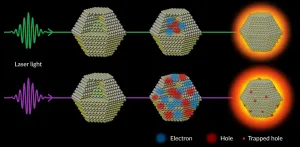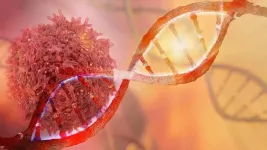(Press-News.org) Narcissism is driven by insecurity, and not an inflated sense of self, finds a new study by a team of psychology researchers. Its research, which offers a more detailed understanding of this long-examined phenomenon, may also explain what motivates the self-focused nature of social media activity.
"For a long time, it was unclear why narcissists engage in unpleasant behaviors, such as self-congratulation, as it actually makes others think less of them," explains Pascal Wallisch, a clinical associate professor in New York University's Department of Psychology and the senior author of the paper, which appears in the journal Personality and Individual Differences. "This has become quite prevalent in the age of social media--a behavior that's been coined 'flexing'.
"Our work reveals that these narcissists are not grandiose, but rather insecure, and this is how they seem to cope with their insecurities."
"More specifically, the results suggest that narcissism is better understood as a compensatory adaptation to overcome and cover up low self-worth," adds Mary Kowalchyk, the paper's lead author and an NYU graduate student at the time of the study. "Narcissists are insecure, and they cope with these insecurities by flexing. This makes others like them less in the long run, thus further aggravating their insecurities, which then leads to a vicious cycle of flexing behaviors."
The survey's nearly 300 participants--approximately 60 percent female and 40 percent male--had a median age of 20 and answered 151 questions via computer.
The researchers examined Narcissistic Personality Disorder (NPD), conceptualized as excessive self-love and consisting of two subtypes, known as grandiose and vulnerable narcissism. A related affliction, psychopathy, is also characterized by a grandiose sense of self. They sought to refine the understanding of how these conditions relate.
To do so, they designed a novel measure, called PRISN (Performative Refinement to soothe Insecurities about SophisticatioN), which produced FLEX (perFormative seLf-Elevation indeX). FLEX captures insecurity-driven self-conceptualizations that are manifested as impression management, leading to self-elevating tendencies.
The PRISN scale includes commonly used measures to investigate social desirability ("No matter who I am talking to I am a good listener"), self-esteem ("On the whole, I am satisfied with myself"), and psychopathy ("I tend to lack remorse"). FLEX was shown to be made up of four components: impression management ("I am likely to show off if I get the chance"), the need for social validation ("It matters that I am seen at important events''), self-elevation ("I have exquisite taste"), and social dominance ("I like knowing more than other people").
Overall, the results showed high correlations between FLEX and narcissism--but not with psychopathy. For example, the need for social validation (a FLEX metric) correlated with the reported tendency to engage in performative self-elevation (a characteristic of vulnerable narcissism). By contrast, measures of psychopathy, such as elevated levels of self-esteem, showed low correlation levels with vulnerable narcissism, implying a lack of insecurity. These findings suggest that genuine narcissists are insecure and are best described by the vulnerable narcissism subtype, whereas grandiose narcissism might be better understood as a manifestation of psychopathy.
INFORMATION:
The paper's other authors were Helena Palmieri, an NYU psychology doctoral student at the time of the study, and Elena Conte, an NYU psychology undergraduate student.
DOI: 10.1016/j.paid.2021.110780
A study by prof. Bas van Bavel and prof. Marten Scheffer shows that throughout history, most disasters and pandemics have boosted inequality instead of levelling it. Whether such disastrous events function as levellers or not, depends on the distribution of economic wealth and political leverage within a society at the moment of crisis. Their findings on the historical effects of crises on equality in societies are now published open access in Nature HSS Communications.
It is often thought that the main levellers of inequality in societies were natural disasters such as epidemics or earthquakes, and social turmoil such as wars and ...
CHAMPAIGN, Ill. -- Materials that contain special polymer molecules may someday be able to warn us when they are about to fail, researchers said. Engineers at the University of Illinois Urbana-Champaign have improved their previously developed force-sensitive molecules, called mechanophores, to produce reversible, rapid and vibrant color change when a force is applied.
The new study led by postdoctoral researcher Hai Qian, materials science and engineering professor and head Nancy Sottos, and Beckman Institute of Advanced Science and Technology director Jeffrey Moore is published in the journal Chem.
Moore's team has been working with mechanophores for more than a decade, but past efforts have produced molecules that were slow to react and return to their original state, if at all. ...
Bright semiconductor nanocrystals known as quantum dots give QLED TV screens their vibrant colors. But attempts to increase the intensity of that light generate heat instead, reducing the dots' light-producing efficiency.
A new study explains why, and the results have broad implications for developing future quantum and photonics technologies where light replaces electrons in computers and fluids in refrigerators, for example.
In a QLED TV screen, dots absorb blue light and turn it into green or red. At the low energies where TV screens operate, this conversion of light from one color to another is virtually 100% efficient. But at the higher excitation energies required for brighter screens and other ...
In the year since the coronavirus pandemic upended how just about every person on the planet interacts with one another, video conferencing has become the de facto tool for group collaboration within many organizations. The prevalent assumption is that technology that helps to mimic face-to-face interactions via a video camera will be most effective in achieving the same results, yet there's little data to actually back up this presumption. Now, a new study challenges this assumption and suggests that non-visual communication methods that better synchronize and boost audio cues are in fact more effective.
Synchrony Promotes Collective Intelligence
Researchers from Carnegie Mellon's Tepper School of Business and the Department of Communication at the University of California, Santa ...
Despite having remarkable utility in treating movement disorders such as Parkinson's disease, deep brain stimulation (DBS) has confounded researchers, with a general lack of understanding of why it works at some frequencies and does not at others. Now a University of Houston biomedical engineer is presenting evidence in Nature Communications Biology that electrical stimulation of the brain at higher frequencies (>100Hz) induces resonating waveforms which can successfully recalibrate dysfunctional circuits causing movement symptoms.
"We investigated the modulations in local ?eld potentials induced by electrical stimulation of the subthalamic nucleus (STN) at therapeutic and non-therapeutic frequencies in Parkinson's disease patients ...
LA JOLLA--The glow of a panther's eyes in the darkness. The zig-zagging of a shark's dorsal fin above the water.
Humans are always scanning the world for threats. We want the chance to react, to move, to call for help, before danger strikes. Our cells do the same thing.
The innate immune system is the body's early alert system. It scans cells constantly for signs that a pathogen or dangerous mutation could cause disease. And what does it like to look for? Misplaced genetic material.
The building blocks of DNA, called nucleic acids, are supposed to be hidden away in the cell nucleus. Diseases can change that. Viruses churn out genetic material in parts of the cell where it's not supposed to be. Cancer cells do too.
"Cancer cells harbor damaged DNA," says ...
New clues to a long-pursued drug target in cancer may reside within immune cells, researchers at the University of Michigan Rogel Cancer Center have discovered.
The findings, which appear in Nature Immunology, not only shed new light on cancer immunology, they also suggest clinical trials related to this key target -- an interaction that destabilizes the important p53 tumor suppressor protein -- may unnecessarily be excluding a large number of patients.
The researchers are optimistic that the findings could help make immunotherapy treatment more effective against ...
CORVALLIS, Ore. - Warm river habitats appear to play a larger than expected role supporting the survival of cold-water fish, such as salmon and trout, a new Oregon State University-led study published today found.
The research has important implications for fish conservation strategies. A common goal among scientists and policymakers is to identify and prioritize habitat for cold-water fish that remains suitably cool during the summer, especially as the climate warms.
This implicitly devalues areas that are seasonally warm, even if they are suitable for fish most of the year, said Jonny Armstrong, lead author of the paper and an ecologist at Oregon State. He called this a "potentially severe blind spot for climate change adaptation."
"Coldwater ...
Lithium-ion batteries have made possible the lightweight electronic devices whose portability we now take for granted, as well as the rapid expansion of electric vehicle production. But researchers around the world are continuing to push limits to achieve ever-greater energy densities -- the amount of energy that can be stored in a given mass of material -- in order to improve the performance of existing devices and potentially enable new applications such as long-range drones and robots.
One promising approach is the use of metal electrodes in place of the conventional graphite, with a higher charging ...
Many psychiatric disorders have genetic causes, but the exact mechanism of how genes influence higher brain function remains a mystery. A new study provides a map linking the genetic signature of functions across the human brain, a tool that may provide new targets for future treatments.
Led by Bratislav Misic, a researcher at The Neuro (Montreal Neurological Institute-Hospital) of McGill University, a group of scientists performed machine learning analysis of two Open Science datasets: the gene expression atlas from the Allen Human Brain Atlas and the functional ...





